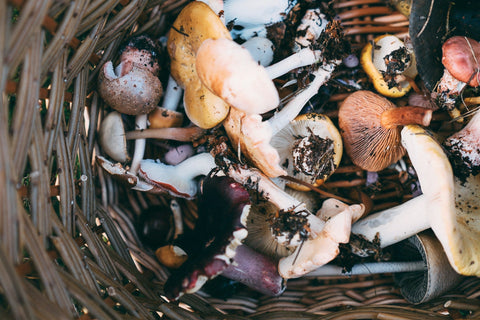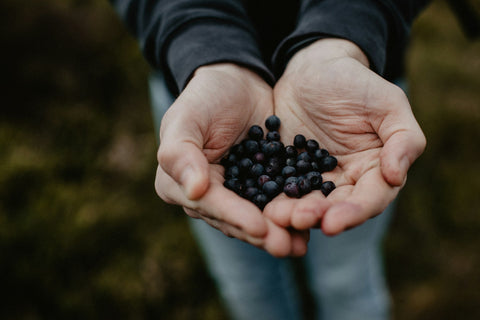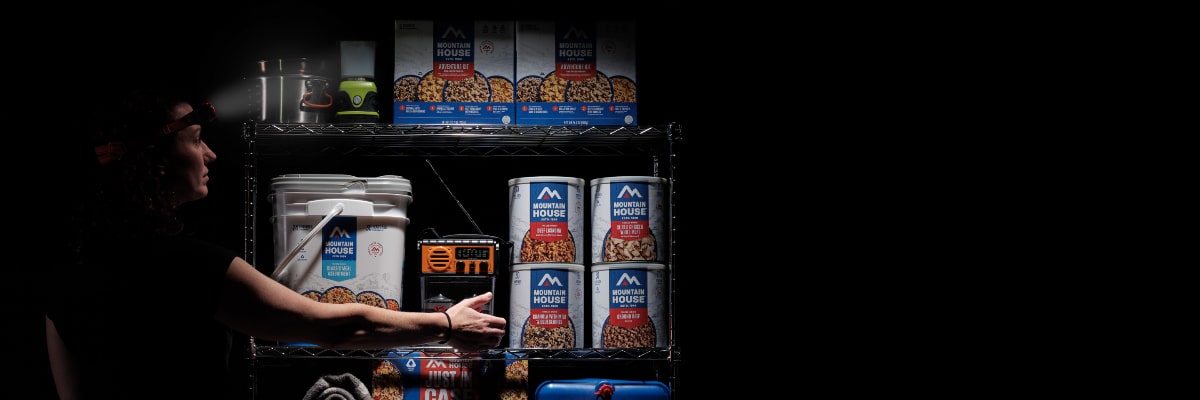Inspired for an Adventure? Check out Beef Stroganoff - Pouch and Beef Stew - Pouch
Free Ground Shipping On All Orders
Over 2,100 Reviews
Add description, images, menus and links to your mega menu
A column with no settings can be used as a spacer
Link to your collections, sales and even external links
Add up to five columns
Add description, images, menus and links to your mega menu
A column with no settings can be used as a spacer
Link to your collections, sales and even external links
Add up to five columns


Foraging for wild foods is, needless to say, as ancient as human activities come. That said, many folks in industrialized countries are many generations removed from the practice, accustomed as they are to getting their eats from grocery stores and restaurants.
Recently, there’s been an increasing shift of attention back toward finding foods in the wild (including on the part of big-name superstar chefs such as Noma’s René Redzepi). Foraging done right can boost the quality of your diet: Wild greens, for example, tend to be rich in vitamins and nutrients, often more so than their cultivated counterparts, and you’ve got the advantage of being able to gather them at their freshest. The pursuit also benefits your health in another way: by getting you out and about on foot.
Other rewards include the chance to connect more deeply with local landscapes—even urban and suburban ones—and to lock into the natural cycles of the year by tracking the phenology (seasonal changes) of plants and mushrooms.
Many people forage regularly to supplement and enhance their daily diet. Knowing how to forage for food is also very much a valuable survival skill!

Let’s talk about the basics of how to forage for food: not so much detailing a ton of different wild edibles (that’s best learned—as we’ll get into—via good field guides and expert instruction) but running through some general approaches and best practices. We’ll also explore some of the potential risks and certain precautions to take.
The Basics of Foraging for Food in the Wild (or the Not-so-Wild)
What exactly is foraging for food? Well, if you want to get technical about it, we do it every day: from the produce (and, admit it, junk food) aisle to our own refrigerator. You forage in your garden. But in this context, when we say "foraging" we’re talking about seeking out and gathering wild-grown foods.
(Given foraging tends to imply seeking out “passive,” immobile foodstuffs, it’s distinguished from hunting and fishing, which are related and time-honored ways of extracting sustenance from the landscape.)
Humans have passed down the wisdom of gathering particular wild foods in a particular place for millennia. Many of us, though, no longer have that wisdom passed down to us from an early age, nor do we necessarily think of our local landscapes as foraging grounds. But even cityscapes tend to be flush with edible wild plants, from urban parks and greenways to abandoned lots.
Foraging wild foods (even in a survival situation) is not something to be done without knowing what you’re doing. As we’ll get into, doing this without the proper knowledge and caution can get you sick—or worse. So the best way to start foraging—or to forage in a geography unfamiliar to you—is to go out with an experienced expert and to read up on field guides and other authoritative reference materials for the specific place in question. If you’re lucky, a relative or friend is a veteran forager and can teach you the ropes; if not, there are often many opportunities to take a class or guided hike focused on identifying wild edibles.
Make the effort to take a class, learn from a knowledgeable forager, and study field guides: You want to be confident that what you’re harvesting is safe to eat or otherwise use.
What to Forage
Many beginner foragers are surprised to learn just how many different wild edibles can be found close to home, no matter where they live.
Many widespread groundcover plants produce edible leaves and/or shoots, from wild leeks (ramps) and lamb’s quarter to wood sorrels, nettles, and dandelions (yes, dandelions—all parts of which are technically edible). A great variety of wild roots, bulbs, and tubers, which can be especially nutritionally rich, are also edible.
Wild berries as well as acorns, chestnuts, and other “hard mast” offer another big-time category of botanical edibles out in the field. But certain flowers (such as those of dandelions and elderberries) can also be eaten.
And when we say “wild,” we ought to emphasize we’re including non-native naturalized plants. Some highly invasive and ecologically undesirable species offer prime foraging opportunities: Himalayan blackberry, for instance, is a fast-growing, fast-spreading scourge on native vegetation communities of the Pacific Northwest (where we’re based here at Mountain House), but it sure provides abundant and luscious berries—right into the heart of Northwest cities, towns, and farmland.
Mushrooms are another classic foraging focus, with a huge range of species. From morels and chanterelles to boletes and oysters, some of these mushrooms are not only edible, but considered legitimate culinary delicacies.

Coastal foragers get to add seafood to the mix: from edible seaweeds to bodacious bivalves.
Where to Forage
We stressed up top that safe foraging demands a conservative mindset. First and foremost, that’s because of the potential danger of becoming ill, but you also need to be aware of local rules and regulations on land use.
Foraging may not be allowed in some areas of public land (many national parks in the U.S., for example), while on other land, it may be legal but carefully regulated—with, say, permits required for harvest over a certain amount. You shouldn’t be foraging on private land without obtaining permission. There are often large gray areas when it comes to municipal properties such as city parks. So the key is to check with local authorities in charge of whatever area you’re interested in to confirm whether foraging is allowed and, if so, how it can be done.
When to Forage
Foraging, as we mentioned, is a great way to start keying into the passage of the seasons. Few wild food resources (of a specific form, anyhow) are available all year round. Some edible plants are only easily identifiable at certain times of the year and may be hard to tell apart from poisonous plants or unpalatable varieties otherwise. Timing, basically, is everything.
Many edible greens are best eaten in spring when they’re most soft and succulent. Stinging nettles, for instance, are best harvested before they flower. Berries tend to be midsummer to fall foods. Mushrooms are often spring (e.g., morels) or fall (chanterelles, hedgehogs, etc.) resources, though some—certain boletes, for example—can have both spring and fall flushes.
From a rich patch of wild onions, wild garlic, or blueberries to a productive chanterelle site, knowing reliable spots for particular wild foods is priceless. The most prized/edible period for a certain plant may not be when it’s most conspicuous. Keep your eyes peeled throughout the year, and you may be able to key into a promising bed of greens by I.D.-ing the species in the summertime, then noting the location so you can beeline there for foraging in the early spring.

That speaks to the value of keeping a foraging journal or logbook: Noting in detail not only where you find fertile sites of a particular food but how that plant or mushroom changes throughout the seasons and any differences in timing or productivity year-to-year can vastly improve your foraging prowess.
Foraging Safety
While many wild foods are safe to eat—and utterly delicious—a slew of them can be harmful or even deadly. Some prized foraging species are deceptively similar-looking to toxic ones. That’s true, for example, of wild carrot (Queen Anne’s lace), which can very easily be confused with the potentially lethal poison hemlock. Lookalikes causing everything from gastrointestinal upset to severe, even life-threatening, illness are notorious when it comes to mushroom foraging.
In other words, you want to be certain of your I.D. before harvesting and consuming any wild food. This points back to the value of a detailed and geographically specific field guide or reference guidebook and of taking either formal or informal instruction in foraging from a reputable guide.
As with any food, it’s also true that what one person can safely and happily eat might not agree with another. Even when you’re certain that you’re gathering a safe-to-eat wild food, start with a small quantity and monitor your reaction to it.
Also, urban or farmland foraging comes with the risk of gathering plants that may have been sprayed with herbicides, pesticides, or other chemicals. While some such treated greens or flowers may be safe to eat with thorough rinsing, it’s best to stay on the safe side and forage in chemical-free environments (which takes doing your homework and being diligent about monitoring).
Processing Your Wild Harvest
Some edible wild plants and mushrooms can be eaten raw, while others are best cooked beforehand. There’s just about an endless variety of preservation and cooking techniques you can employ with wild edibles, from making elderberry flower cordials to drying nettle leaves for tea and wild mushrooms for a seasoning powder.
Take Mountain House on Your Foraging Journey
Whether you’re setting up camp for huckleberry or mushroom season or beefing up knowledge about local wild edibles as part of your emergency preparedness plan, Mountain House meals vibe perfectly with foraging. Many wild greens or edible mushrooms have been added to one of our freeze-dried meals at the campsite, for one thing! Explore our full collection—and happy foraging!

How to Rotate Emergency Food: FIFO and Other Rotation Methods

The First 72 Is on You: Survival Kit Checklist + Printable PDF


Stay Hungry for Adventure
Sign Up for Delicious Outdoor Meals & Exclusive Offers!
By clicking ‘Join Now’, I agree to the Terms of Service and Privacy Policy.


Join the adventure
©2025 Mountain House — All Rights Reserved.
Your Cart is Empty
Continue ShoppingYour Cart
Subtotal
$0.00
EXPRESS PAYMENT METHODS AVAILABLE IN CHECKOUT
Taxes and Shipping Calculated at Checkout
Your ExpertVoice deal.
$[Deal Price]
$[Original Price]
Discount applied at checkout.
On sale now — lower than your ExpertVoice discount.
Not eligible for ExpertVoice discount.














